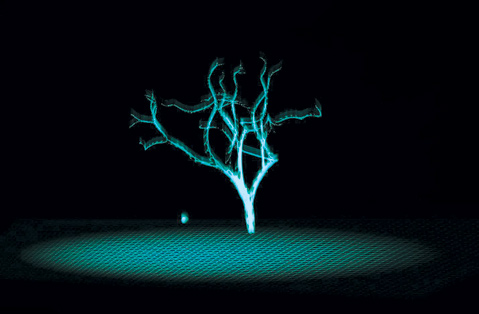Review: Ruckus at The Arts Fund

Perhaps the most common way we experience how technology transforms art is in music. Depending on your age, you might remember the first time you heard a song by Chuck Berry, Jimi Hendrix, or Nine Inch Nails that forever changed what music could be. As with music, when we encounter this kind of quantum leap in the realm of visual art, it is at first disorienting. But as soon as we get over the initial shock, it can also produce an incredible sense of wonder.
The collection of work on view through August 16 at the Arts Fund Gallery is full of these kinds of awe-inducing moments, where technology is put to creative use to make something thoroughly unfamiliar. As you enter the gallery space, you immediately encounter “The Font,” an imposing metal cauldron filled with water of ever-changing colors. Connected to this is a microphone that transmits to a speaker inside “The Font,” creating a complex series of Faraday waves on the surface of the water that responds to the pitch of your voice. This display is then projected onto the walls above. The piece is collaboration by artists Carlos Padilla, Alan Macy, Jonathan Smith, and Ethan Turpin, who have produced something that is unique and remarkably captivating.
Macy’s solo effort for this show, “Sensory Perception Chair — Breathing,” comes in the form of a plush red chair adorned with similarly colored wings. When the chair is occupied, it slowly syncs with the breathing patterns of the sitter, and within moments the wings begin to move back and forth in rhythm. There are no obvious sensors in the chair to explain how this interaction takes place, amplifying the sense of mystery that such an object creates. However, the experience of sitting in the chair itself is so soothing that it is easy to want to linger there.
On the opposite side of the gallery, Turpin uses antiquated video equipment from the 1980s and ’90s to produce “Video Feedback Temperatures,” part of his Video Feedbackteria series. This iteration takes a video of the viewer and their surroundings to produce colorful abstract patterns that slowly evolve into biomorphic shapes. As with the rest of this series, the astonishment here comes from just how organically this feedback seems to behave. It is absolutely mesmerizing.
The final two exhibitors for this show come from UCSB’s Media Arts and Technology graduate program, one of this country’s single greatest centers for this kind of avant-garde art. Tim Wood’s “Kodama” uses a repurposed Xbox video sensor to detect the viewer’s body movement and translates that motion into a digitally rendered tree on the screen above. Wood is also a dancer, and this piece is a beautiful exploration of the intersection of the physical and the virtual. Marco Pinter has created what is probably the most cerebral piece in the show, “Object Permanence 3: Non-Dual.” Over the course of four-and-a-half minutes, three digital screens depict a variety of shapes that move from one screen to the next, at times seeming to interact with the sculpted elements installed in the spaces around the screens. The interaction confuses our understanding of how the real world affects the virtual world, and vice versa.
From an artistic standpoint, it can be a challenge to discuss this kind of work, which seemingly requires an entirely new vocabulary. But there is certainly a distinct kind of beauty in the way this work asks us to redefine what art can be. For the art lover who gets excited by the idea of exploring the cutting edge, this show will not disappoint



